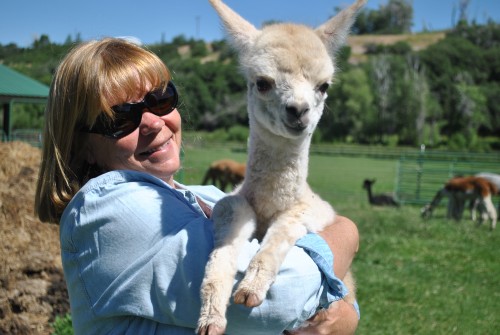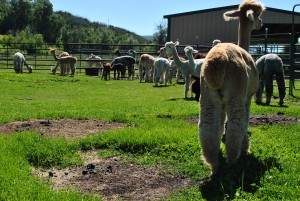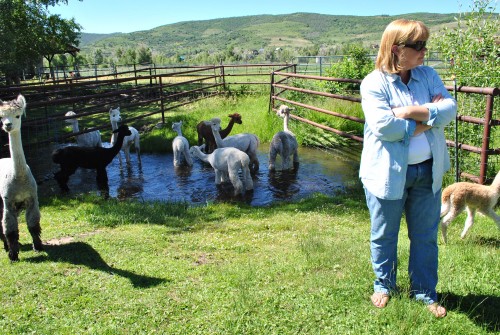Woodland Utah proves an ideal place to raise Alpacas. Linda Gardner’s farm shows the gentle cousins of Llamas make good business for ranchers.
by Kylee Hill
Driving from Salt Lake City to Blue Noon Ranch in Summit County, Utah is like taking a tour of all of the lifestyles available here. The energy of the city morphs into the natural beauty of Parley’s Canyon; the freeway winds through the relaxed affluence of Park City to the tight-knit community of Kamas. Further still, through a tiny one-store town called Francis, the road meanders up and down hills, fields and glimpses of river that look like scenes from postcards.
Visiting the ranch, surrounded by trees and blue skies, it’s not hard to see why Linda Gardner chose this life. But she didn’t always plan on being an alpaca rancher in Woodland, Utah. Her job titles have varied from special education teacher to licensed massage therapist to mother of three. She and her husband, Ed Heintz, were living in the suburbs of Sandy when Linda happened upon a magazine advertisement during a plane ride which read, “Why not have an investment you can hug?”
The rest is history. Upon arriving you can see the unusual creatures grazing in their fields behind the log cabin style house that Linda and Ed built themselves. They started with one alpaca, in 1998 and Linda instantly fell in love. In 2005 they moved to Woodland and she started ranching full-time. Now, Blue Moon Ranch boasts a herd of over 70 animals. Despite that impressive number, Linda insists with a laugh that they are “easier to take care of than my six dogs.”
These gentle, intelligent animals have been domesticated for over 5,000 years in the mountains of South America, but have only been available in the United States since 1984. Alpacas weigh about 150 lbs and produce a valuable soft fiber that is used to make everything from socks to house rugs. Before the recession, a single alpaca could be sold for fifteen to twenty thousand dollars. Now, prices for a quality animal are half that amount.
“In a way, it’s a good thing, because now it’s accessible to more people,” Linda says. Blue Moon Ranch operates every possible facet of the Alpaca business, from a carefully controlled breeding program (four babies, called cria, have been born on the ranch this year) to fiber production and animal sales. Linda spends a few hours each day on her computer, answering questions, marketing the business, and scheduling ranch visits. Her website even offers a live “alpaca cam” where people can watch the herd in their fields in real time.
“It’s a very green business model. We do everything here, nothing goes to waste.” She points to a mound of composting manure and explains that they even give the “alpaca beans” to local farmers and use it to fertilize their fields. Inside the garage, sheets of fiber fresh off her animals lie in stacks. Spools of soft alpaca yarn hang from the walls; a tiny photo of the alpaca that each one came from is attached on a string.
It’s clear that this is more than a business to Linda. Every single one of her alpacas has a name, and as she wanders through their pasture, they approach her like old friends. She often gets talked into taking in older, retired animals from friends. As we talk, she swings a gate open and leads the herd down to “the beach,” a river that runs through the field, to cool off in the heat. A cria wanders down to the edge of the water and she quickly scoops the baby into her arms. “No, not you,” she tells him. “You’re too little.”
Raised in Chicago, she used to ask her father to take her to the stockyards to see the animals. “I’ve always loved livestock. And I never thought Utah, but here I am,” she laughs. It’s a feeling that Blue Moon Ranch is hoping to spread. Alpaca ownership has become popular on the east coast, but it’s still a fledgling industry in the west. “Anyone who has land should have alpacas,” Linda says. She points out that a single horse eats as much hay as ten alpacas.
Every year at the end of September, Blue Moon Ranch hosts a two-day open house when visitors can come tour the property, meet the herd, and browse an impressive selection of locally produced alpaca products. Last year they received over 500 visitors. This year’s festival is scheduled for Sept. 24th – 25th. Linda encourages anyone curious about the species to come for a visit: “They’re the best animals in the world!” §

